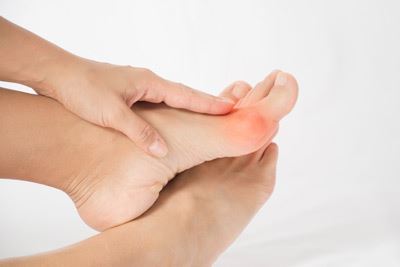-
Home
-
Bunions: Symptoms and Treatment
Bunions: Symptoms and Treatment
May 10, 2019

While seemingly a small part of the body, feet are extremely complex. Bones, joints and ligaments all work in unison to keep people moving, and when even a small issue arises, pain and inconvenience are sure to follow. The long-term effects of bunions demonstrate how a minor foot issue can lead to major problems if not properly identified and promptly addressed.
What is a Bunion?
Bunions form on the joint near the base of a big toe. According to the Mayo Clinic, this is often a result of friction between the big toe and the next toe over, leading to a bony bump on the outside of the foot.1 The exact cause of bunion development is not entirely known, and experts are not all in agreement as to whether genetics, among other factors, play a role in bunion growth. However, over time, tight shoes, arthritis, stress and structural defects can all contribute to bunion occurrence, as well as occupations that involve a lot of standing and walking. To identify a bunion before pain increases, look for bumps, swelling and calluses on the outside of the foot. If movement becomes painful or restricted, it’s time to seek medical treatment.
What Are Your Surgical Options?
If a bunion grows painful enough, surgery may be required. Many times, a bunionectomy is performed, which is a procedure that shaves off the bulging area of the bunion. For more severe cases, doctors may make a more intrusive incision and rotate the bone to a more comfortable position. Those who go under the knife to address bunions should be aware, however, that it is not a surefire fix to pain or symptoms, could lead to restricted foot use for weeks and may take as long as a year to fully mitigate pain. In fact, the Harvard Health Publishing says surgery should not be rushed into, and certainly not done for cosmetic purposes alone.2
Treatments Outside of Surgery
Conservative treatment measures can often lead to a simple solution for bunions. For example, switching to a roomier or more supportive shoe can temper swelling and pain. Shoe inserts can better distribute weight, taking pressure off the bunion. Padding, taping and splinting within the shoe can also provide pain- and stress-relief. Over-the-counter medications like Tylenol, Advil and cortisone injections can help to reduce or eliminate pain as well. Applying ice has also proven to minimize swelling and pain.
AliMed Solutions
AliMed's selection of proven, professional bunion splints provide non-operative treatment solutions to help alleviate pain, pressure, discomfort and skin irritation.
- PediFix® Visco-GEL® ToeBuddy™ Bunion Guard™ – This dual-action device cushions and aligns the first and second toes while protecting the bunion joint from shoe pressure and friction.
- PediFix® Visco-GEL™ Dual-Action Bunion Guard™ – A combo Gel toe spacer helps separate and align first and second toes that rub together, the gel bunion guard cushions and protects the big toe joint and the Visco-GEL® releases mineral oil and vitamin E to soothe, soften and moisturize feet.
- Silipos® Day and Night Gel Bunion Splints – A comforting removable gel cushion protects against friction and pressure with adjustable straps and a hinged splint to distribute pressure and provide corrective support.
- Silipos® Active Gel Bunion Sleeves – This medical-grade, anatomically-designed mineral oil gel pad comfortably conforms to bunion shape, cushioning, protecting and reducing pressure on the affected area.
For more information about all of AliMed’s solutions for bunion discomfort, treatment and post-operative recovery, click here.
References
- https://www.mayoclinic.org/diseases-conditions/bunions/symptoms-causes/syc-20354799
- https://www.health.harvard.edu/diseases-and-conditions/what-to-do-about-bunions